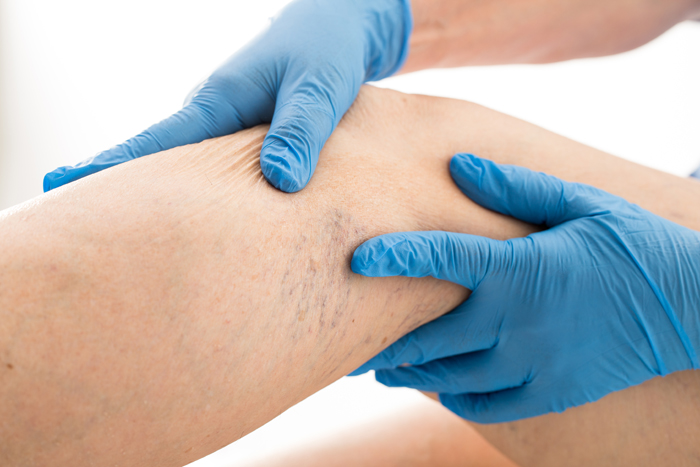Venous Insufficiency Treatment in Sadashiv Peth, Pune
Damaged vein walls hinder the flow of blood causing various disorders called venous diseases. Venous diseases include blood clots, deep vein thrombosis, chronic venous insufficiency, superficial venous thrombosis, and varicose veins. Venous disease is common. While some of these conditions like varicose veins do not pose a serious risk, some conditions like thrombophlebitis can be life-threatening.
What are venous diseases?
Veins have flaps called valves inside them. The valves open to allow the blood to flow through the veins when your muscles contract. When your muscles relax, these valve closes and hence prevents the blood from flowing back. Therefore, this ensures the flow of blood in one direction. When the veins get damaged, it allows blood to flow in the backward direction when your muscles relax. This leads to a buildup of high pressure in the veins. The buildup leads to the twisting and stretching of veins. This causes blood clots and sluggish blood flow in the veins.

What are the symptoms of venous diseases?
The symptoms of venous veins are as follows:
- Varicose veins: swollen, clustered, purple veins, caused by weakening in blood vessel walls.
- Superficial thrombosis: Blood clot forms near the surface of the skin and causes pain. These blood clots do not travel to the lungs unless they move into the deep venous system.
- Deep vein thrombosis: the blood clots occurring in the deep veins are called deep vein thrombosis (DVT). these generally develop in arms or legs. These are not life-threatening but there is a risk of these clots breaking free and travel in the bloodstream. This can accumulate in the blood vessels of the lungs and can be life-threatening.
- Chronic venous insufficiency: chronic venous insufficiency leads to chronic leg swelling, pooling of blood, increased pigmentation, discoloration of the skin, and leg ulcers.
- Ulcers: these are wounds or open sores usually located below your knee caused by static blood flow.
What causes venous veins?
The various reasons for venous veins are as follows:
- Due to immobility, the blood flow gets stagnant leading to ulcers and blood clots. This can even happen to a healthy person who stays still for a prolonged duration of time. This is common among bedridden patients.
- Injury in blood vessels is caused due to trauma, infectious organisms, or external instruments like catheters and needles.
- The deficiency of anti-clogging factors in your body can cause your blood to coagulate leading to venous diseases.
When to see a doctor?
If you are facing unexplained swelling in your arm or leg, or a swelling in your veins that does not go away in few days, then you must see a doctor.
Request an appointment at Apollo Spectra Hospitals, Jaipur
Call 1860-500-2244 to book an appointment
How can we treat venous diseases?
The surgical procedures to treat varicose veins are as follows:
- Sclerotherapy: your doctor injects a solution into your small and medium-sized veins that scars them. Hence, these veins are closed and your blood is re-directed to healthier blood vessels. This procedure is used to treat superficial varicose veins.
- Laser therapy: This is a newer technology that is used to treat varicose veins.
- Surgical ligation: the varicose veins are tied off and stripped in severe cases.
The non-surgical procedures to treat thrombophlebitis are as follows:
- Your doctor might prescribe an anti-clogging medication usually heparin, that should be given to you intravenously for 7 to 10 days. You might be hospitalized or you can visit on an outpatient basis. This process is recommended when you have deep-vein thrombosis.
- If you have superficial thrombophlebitis, you will be recommended to exercise and keep yourself physically active. The progress of blood clot formation is recorded over time.
- Clot dissolving agents like tissue plasminogen activator or urokinase is administered in your body to dissolve the clots and resolve the issue.
- Your doctor might recommend you to wear special elastic support stockings to aid circulation in your legs.
- Your doctor might implant a filter in your veins to filter out blood clots from reaching the lungs.
References:
https://my.clevelandclinic.org/health/diseases/16754-venous-disease
https://www.hopkinsmedicine.org/health/conditions-and-diseases/venous-disease
You can usually detect varicose veins by observation. In some cases, X-rays may be done to ensure the results.
In most cases, non-surgical methods are sufficient to treat venous diseases. But based on the severity of your condition, your doctor might recommend surgical procedures too.
If your case is mild, try the elevated foot method. You are required to raise your affected foot around two to four inches above the bed using blocks to aid circulation while you sleep.
Symptoms
Our Top Specialities
NOTICE BOARD
CONTACT US
CONTACT US
 Book Appointment
Book Appointment


.svg)
.svg)
.svg)
.svg)








